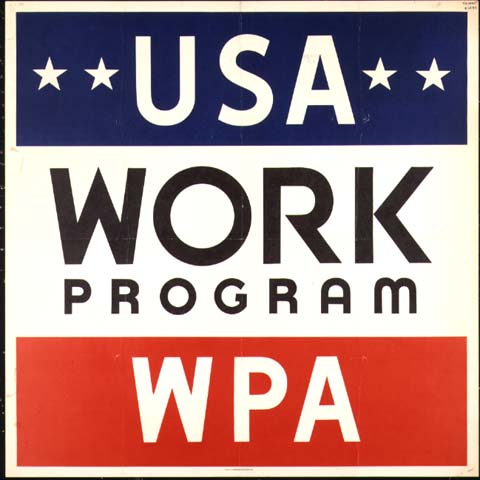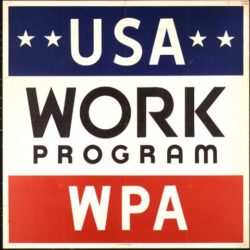Federal Writers Project
The Federal Writers Project in Louisiana produced oral histories, local guidebooks, and other writings between 1935 and 1939.

Courtesy of Library of Congress Prints and Photographs Division
USA Work Program. Unidentified
One of President Franklin D. Roosevelt’s New Deal programs, the Federal Writers Project (FWP) employed out-of-work writers and editors during the Great Depression. Directed by writer Lyle Saxon, the Louisiana branch of the FWP produced two travel guides—The WPA Guide to New Orleans (1938) and Louisiana: A Guide to the State (1941)—and a folklore collection—Gumbo Ya Ya: A Collection of Louisiana Folk Tales (1945). Unique among the FWP offices, the Louisiana FWP also included an all-Black affiliate, the Dillard History Unit, directed by Lawrence Reddick and poet Marcus Christian.
Background and Context
One of five cultural programs collectively known as Federal One, the FWP complemented the efforts of the Federal Art Project, the Federal Theater Project, the Federal Music Project, and the Historical Records Survey. All five agencies administered offices in each of the (then) forty-eight states, meeting with varying degrees of success. At the national level, the Federal One projects were overseen and administered by the Works Progress Administration (WPA), later renamed the Works Projects Administration. Established by congressional legislation in April 1935, the WPA dwarfed all other New Deal job programs, hiring millions of workers for thousands of local projects across America.
Under the supervision of Henry Alsberg, the FWP employed some 6,600 writers, historians, reporters, and editors. Some collected life histories from various sources, including the tales of aging pioneers and slave narratives. Others archived historical records or wrote local histories. But the FWP is best remembered for its extensive array of guidebooks intended to facilitate automobile tourism across the country—one for each state, plus numerous other guides to cities and regions. Known collectively as the American Guide Series, each volume followed a standardized template. The first section presented separate essays on a state’s general background—its history, folkways, architecture, and the like—while the second focused on the state’s cities and towns. The guides concluded with tours designed to take motorists from border to border, north to south, east to west. The first extensive tourist guide to modern America, the series marked a significant cultural milestone, one fraught with meaning for the man who supervised FWP efforts in Louisiana.
Lyle Saxon and the Louisiana Writers’ Program
When Henry Alsberg tapped him to become director of the Louisiana Writers’ Program (LWP), Lyle Saxon resolved to make the most of a second chance. In the late 1920s, Saxon burst upon the national literary scene with three best-sellers that combined travel narratives with popular history and a biography of privateer Jean Lafitte. The latter caught the eye of Cecil B. DeMille, who bought the screen rights and directed the 1938 film, The Buccaneer. Though Saxon often disparaged them as “the eatin’ books” (because they paid his bills while he aspired to more serious literature), Father Mississippi (1927), Fabulous New Orleans (1928), Old Louisiana (1929), and Lafitte the Pirate (1930) earned him celebrity status. In addition, they assured him an honored place in the tradition of Louisiana letters stretching from Grace King to Lafcadio Hearn to George Washington Cable.
Subsequently, Saxon embarked on what became his only novel, Children of Strangers, a sensitive treatment of complex racial themes set in the Creole colony of Isle Brevelle along Cane River in northern Louisiana. Progress on the novel proved slow and Saxon lapsed into a deep, harrowing silence. Summoned back to New Orleans at the FWP’s behest, Saxon saw a chance to regain his place as the literary voice of Louisiana.
Saxon spent much of the following year establishing his project statewide, a complicated task ably facilitated by one of the first people he hired, Eddie Dreyer. Having studied literature at Tulane, Dreyer attended Duke University in North Carolina before returning to New Orleans in 1935 to look for a job. Saxon discovered him working as a Federal Emergency Relief Administration clerk, made him his administrative assistant, and never regretted the choice. The two developed a close personal and professional relationship that proved mutually beneficial. Dreyer’s attention to bureaucratic detail, not to mention his sharp eye for extraneous modifiers, freed Saxon to rove about the state, organizing offices in every Louisiana congressional district and promoting the FWP through speaking engagements at local civil organizations. As a result, Saxon’s unit became something of a FWP model, renowned for both the efficiency of its operation and the effectiveness of its prose. A self-proclaimed bohemian aesthete, raconteur, and “artist with a jigger of absinthe,” Saxon made New Orleans an unofficial FWP vacation spot and eagerly embraced the role of host.
The Dillard History Unit
The LWP was unique among Deep South projects for another reason. In 1936, Saxon established the Dillard History Unit, an all-Black LWP affiliate sponsored by Dillard University. The unit operated exactly like its parent organization. Writers researched topics in libraries and archives throughout New Orleans and wrote essays that were edited by Dillard history professor Lawrence Reddick and poet Marcus Christian. By 1942, when the unit ceased operation, its cumulative labors had produced The Negro in Louisiana, a 1,200-page manuscript detailing the struggles and achievements of Black Louisianans, beginning with the arrival of the first enslaved Africans in 1719. In many ways, the manuscript anticipated professional historical scholarship. It rejected popular stereotypes of slavery and the postwar South, insisting that Black Louisianans had shaped the state’s folk customs, religious practices, foodways, dancing, speech patterns, dress, and agricultural production in important ways. Chapters emphasized both the harshness of life for enslaved people and their sustained resistance to slaveholders’ power, especially through voodoo rituals.
Throughout its duration, LWP writers, Black and white, followed standard production guidelines. They harvested raw material in the field and then refined this information into essays that were checked and rechecked on their way to Washington. Often with the collaborative efforts of National Youth Administration workers, the process began in local courthouses, archives, and libraries, or with interviews of townsfolk, often elderly. District workers then transformed this material into preliminary reports labeled “field continuity.” Either district editors or specialists in a given field checked this material before sending “field editorial copy” to editors in the state office at New Orleans. Following their review, “state editorial copy” received final scrutiny in Washington.
Publications and Accomplishments
In addition to The Negro in Louisiana, the LWP produced three other volumes—two guides and a folklore collection—while establishing a new model for the production of subsequent FWP publications across the country. Rather than sending his manuscript to the Government Printing Office, as other state directors had done, Saxon negotiated with Houghton-Mifflin, whose production values and marketing resources guaranteed a more polished book for a wider audience. The office of then-New Orleans Mayor Robert Maestri facilitated this process. The result, The WPA Guide to New Orleans (1938), remains among the definitive volumes in the American Guide Series. Lavishly illustrated and crisply written, the guide helped establish the city’s reputation as a preeminent tourist destination. New Orleans had all the modern conveniences, Saxon asserted, but because of its complex demography, festival tradition, rich cuisine, and distinctive architecture, the city lacked modernity’s attendant ills, chiefly social intolerance and cultural homogenization. Here was a place like no other in America, an exotic Creole society, a place of sensual indulgence and hedonistic abandon, the “city that care forgot.”
The two subsequent WPA publications proved less satisfying and more frustrating. In 1939, Saxon began to show symptoms of the stomach cancer that eventually killed him in 1946. Also in 1939, Congress reorganized the WPA, ending what had been a rewarding relationship between Saxon and Henry Alsberg and beginning what was to be a less satisfactory relationship with John Newsome, Alsberg’s successor.
More than anything, however, the final publications of the Louisiana FWP were hurt by Saxon’s failure to resist the nationalizing influences of modern America. Saxon rose to literary acclaim by positioning himself as the antimodern voice, celebrating the cultures of Louisiana’s insular and heretofore inaccessible places, chiefly the French Quarter. But the WPA work, organized according to a standardized template for a national tourist audience, necessarily undermined Saxon’s authority. His efforts ultimately connected Louisiana with a national community whose homogenizing influences were all too evident. Published by Hastings House in 1941, the suggested tours featured in Louisiana: A Guide to the State not only identified the state’s links with the burgeoning US highway network but also facilitated the mass influx of motoring tourists.
Gumbo Ya-Ya (1945), Saxon’s final attempt to keep modernity at bay, collected folktales, ghost stories, Carnival lore, and other tales within New Orleans and across the state. Though he defended the volume as “my pet” and insisted that Gumbo Ya-Ya represented “the real, under-the-crust” Louisiana, the theory and methodology of modern folklore collection and ethnography rendered it obsolete from the moment of its publication and limited release. Saxon’s WPA work had hastened the very transformations he had struggled so hard to arrest.
At the national level, a conservative backlash in Congress prompted the beginning of the end for the WPA in general and the FWP in particular. In 1939, Congress abolished the Federal Theater Project outright, and stripped the remaining national offices of their supervisory capacity. It also forced the affiliated state offices to secure local sponsorship. The entire operation closed in 1943, when the WPA was terminated.
